|
|
FUGUE:
CHAPTER V1a
THE
ORGAN AT ARMLEY FROM 1879 TO THE REBUILD BY
J.
J. BINNS IN 1905, WITH A DETAILED SPECIFICATION
Two
individuals deserve special recognition for their devoted care of
the organ during its early years at Armley - Thomas Cawthra, the
first organist, and James Jepson Binns, the organ-builder.
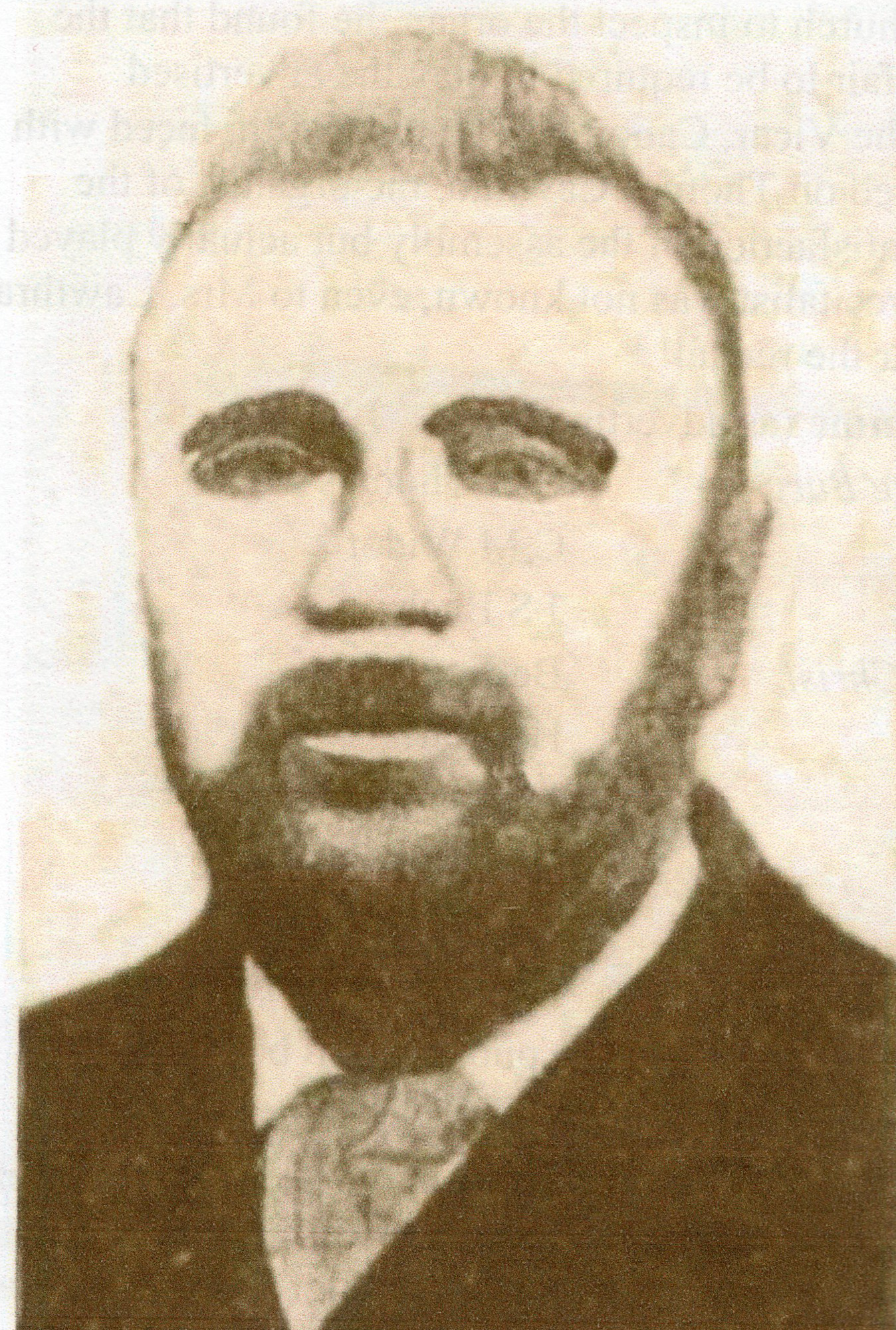
|
|
Thomas
Cawthra (left), organist of St. Bartholomew's from
1878 until his death in 1921, was an accomplished musician with
a great love for the instrument over which he presided with
such distinction for 42 years. A true Yorkshire-man in dialect,
blunt, independent and with a good sense of humour, many
stories have been told of his encounters with visitors to the
organ loft. Allbutt relates how a young organ-builder attempted
to give Cawthra advice about his instrument.
Once
when Allbutt visited the church with some friends, Cawthra
extemporised very effectively for them. On returning to the
loft a lady, seeing no music on the desk said, "Did you
play all that out of your head, Mr. Cawthra? What a memory you
must have!" Cawthra accepted the compliment with a grunt
and muttered to himself
"Memory has nowt to do wi'
it.”
|
Cawthra
was immensely proud of the organ and had many interested
visitors. One day two gentlemen appeared, one of whom,
described by Cawthra as a "little, ruddy-faced chap,"
was anxious to see and hear the organ. After a
demonstration, the visitor asked whether he might try it for
himself. "Can you play?" asked Cawthra, remembering past
awkward experiences. "WeIl," said the visitor
hesitatingly, "I might manage the 'Old Hundredth'."
"Very weIl, let's hear it," said Cawthra, who soon found
that the stranger was a fine organist and knew as much about
organs as he did himself. The unknown visitor thanked
Cawthra for the privilege and the pleasure it had given him
to play such an organ and left the church. Cawthra, all
curiosity, asked the second visitor "Who was he?" "Don't
you know?" was the reply, "That was Sir John Stainer,
organist of St. Paul's Cathedral."
Cawthra
was very insistent on his position as custodian of the organ and
when, in the July, 1888, number of the "Yorkshire Musician,"
an article appeared on Isaac Abbott (the Leeds organ-builder) with
these words:
|

|
|
Choral
and Organ Music at Armley Church
Dedication
Festivals at Armley were major events in the new church's year,
and on St. Bartholomew's day (24th August), the anthem was
usually replaced by a short oratorio, or cantata, sung under
the direction of Mr. W. Pickersgill, the devoted choirmaster,
with organ accompaniment played by Mr. T. Cawthra and with
active support from the Vicar, the Rev. F. G. Hume-Smith.
Works
rendered by the choir in the early years of the church were →
|

|
|
Organ
recitals at Armley were very popular at the close of the
nineteenth century, given occasionally by visiting players of
renown, but mainly by Thomas Cawthra himself. The Church Magazine
records that recitals were given on 13th and 14th April, 1891, by
the celebrated Belgian organist Auguste Wiegand, who was appointed
as organist to the Church of St. Giles, Liège, before
reaching the age of seven, and was a pupil of Lemmens. These
recitals were criticised both on the grounds of eccentricities of
tempo and of doubts as to the suitability for the organ of some of
the works played, but a composition by the recitalist which
included a representation of a thunderstorm was received with
enthusiasm by the audience!
On
the occasion of the 57th Annual Meeting of the British Medical
Association, held in Leeds during August, 1889,
Mr.
Cawthra gave a typical recital for the members, probably at the
suggestion of Dr. Clifford Allbutt, with the programme
(right)
Cawthra
could equally well present in a recital three major works for
the organ, e.g. J. S. Bach's B minor Prelude and Fugue, a
Handel Concerto and Mendelssohn's Organ Sonata No. 4 in B flat,
in addition to minor pieces (30th June, 1891).
|
|

|
James
Jepson Binns
By
the year 1905, the maintenance of the organ had passed into the
hands of James Jepson Binns, who cared for it until his death in
1929. Born in Burley, near Leeds in 1855 and apprenticed at
the early age of 11 to Messrs. Radcliffe & Sagar,
organ-builders of Leeds, he later became voicer and tuner to
Messrs. Abbott & Co. (later Abbott & Smith), also of
Leeds. Throughout his life, Binns was a keen musician, being a
chorister as a boy and later having a fine baritone voice. He
became organist and choirmaster at Tadcaster, using a pony to
travel to and from Leeds.
Mr.
J. W. Broughton, chorus master of the Leeds Musical Festival, had
a Schulze chamber organ in his Leeds home which was tuned by young
Binns for Messrs. Abbott & Smith. Knowing of his ambition to
set up for himself as an organ-builder, Mr. Broughton said to
Binns:
“If
you can make a pipe and put it into one of the diapason stops so
that I cannot detect the difference between the
pipe and the
rest, I think I might be able to put you in the way of
starting”
Binns
accepted the challenge, succeeding so well that Mr. Broughton
spoke to several wealthy Leeds men who advanced the necessary
capital to enable Binns to start as an organ-builder. On 2nd
July,1881, the following advertisement appeared in the “Leeds
Mercury”:
“James
J. Binns Organ Builder (late Voicer and Tuner to Mr. Isaac Abbott,
Organ Builder (Leeds), begs to inform his friends
and the
public that he has commenced business as Organ Builder at Lower
Town Street, Bramley, and hopes by prompt
attention and
skilful work to merit their patronage”.
Removing
later to Hough Lane, Bramley, the factory grew to be one of the
largest in England at the time of Binns' death in 1929, the stock
of first-rate mature timber being used by his successors at
Bramley long afterwards. An ardent admirer of Edmund Schulze
and his instruments, Binns' organs were beautifully constructed of
excellent materials, his wooden flutes being examples of
meticulous care in assembly, but in his later years the Binns
organs became stereotyped in design. Built in 1896 at the
height of the Romantic era, the organ at St. Aidan's Church,
Leeds, is a fine example of his craftsmanship with a case of
unusual merit, also made at the Bramley factory.37
Such was the man entrusted with the major
rebuild of the Armley Schulze organ in 1905.
The
organ was at first maintained, and in 1889 cleaned, by Messrs.
Abbott & Smith of Leeds, a firm founded in 1869 by Isaac
Abbott and W. S. Smith. When the organ was installed at
Armley, there was insufficient pressure in the water main to
operate the hydraulic engine used to blow the instrument.
Therefore a two horse-power Crossley gas engine was installed in
the blowing chamber to augment the water pressure and so to assist
the hydraulic engine - a system somewhat similar to that used in
York Minster from 1903-17. The drawbacks to this ingenious
solution were first that Henry Cawthra, son of and assistant to
Thomas Cawthra, had as a boy to hold a lighted taper to the gas
jets of the engine to keep it running, and second that the fumes
from the gas engine had very injurious effects upon both the
bellows and the pipes of the organ. Also, being pumped into
the church, the fumes polluted the atmosphere within the edifice!
Hence, in 1893, when the water pressure in the mains was greater,
the gas engine was removed and two small hydraulic engines by
Speight were installed.
After
some 20 years of use, the action of the organ was adversely
criticised by Dr. William Spark, first City Organist of Leeds, who
wrote in 1892:
“Of
the tones of the magnificent organ it is impossible to speak too
highly, though its mechanism,
especially the drawstop
action, is faulty and noisy – a defect which will have to be
rectified if that
important part of the instrument is to
equal the other”
-
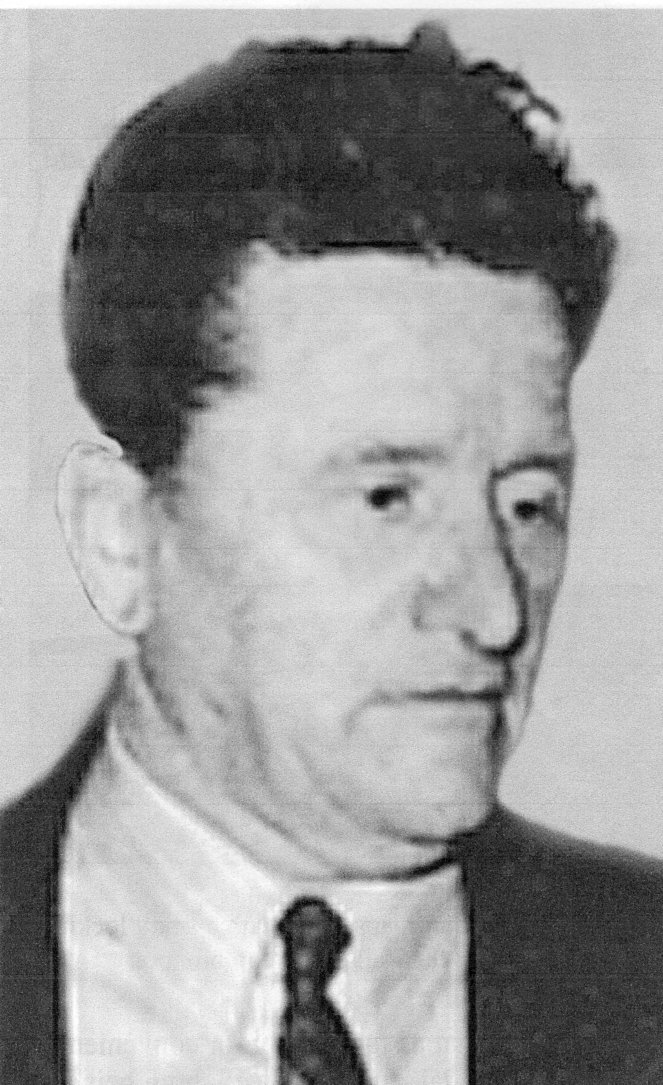
|
In
1900 the organ was again cleaned by Abbott & Smith, the
majority of the pipes being removed to the old church for
this purpose. The swell box received a new "bonnet"
top and new louvres were fitted to improve the degree of
crescendo obtainable, the cost of the whole amounting to
£70. It is probable that at that time the Swell
Rohrflöte 8ft. was replaced by the present Celeste rank
of tapered and slotted spotted metal pipes, since the
workmanship of these pipes corresponds with that of others
by Abbott & Smith, according to Mr. John T. Jackson, the
organ-builder who was maintaining the instrument at the time
of writing in 1978.
In
Jackson’s view, this "inexcusable substitution"
is the only instance of the introduction of pipes other than
by Schulze into the organ, apart from the CCCC pipe of the
Pedal Sub Bass 32ft. (by Binns) and the nine pipes inserted
in the Great Organ to replace those damaged in the 1956
accident described later. The substitution must presumably
have had the approval of Thomas Cawthra the organist who, as
previously related, was at that time the organ's zealous
guardian. Nothing is known as to the fate of the removed
Rohrflöte, but the facts that Binns both engraved the
stop knob in 1905 as "Rohr Flöte" and so
listed the stop in the published specification, suggests
that he was anxious to recover or to replace the original
pipes. Otherwise it must be assumed that the substitution
took place after
1905, which is unlikely.
John
(Tommy) Jackson
|
In
1905, J. J. Binns undertook a major rebuilding of the organ. The
original pneumatic lever action, which had been maintained, and
probably in part replaced, by Abbott & Smith, had become
loose, noisy and erratic - "a source of great vexation to the
player" - in addition to the cumbersome and noisy stop
action. All this was discarded and replaced by tubular-pneumatic
action on the pressure system to manuals, pedals and drawstops,
with a very complete array of couplers made possible by that
action, and tremulants were added to Choir, Swell and Echo Organs
- all of which remained until 1976. Binns was a great exponent of
tubular-pneumatic actions, then greatly in vogue, and the octave
and suboctave couplers, although disturbing the Schulze tonal
balance, were used by many players to compensate for the lack of
separate 2ft. ranks (except in the Echo Organ) and for the absence
of a 16ft. reed stop in the Swell Organ.
Binns
fitted his patent adjustable combination pistons to manuals and
pedals, four to Great and Pedal (duplicated by combination
pedals), four to Swell (also duplicated by combination pedals),
three to Choir and three to Echo. The desired combination set up
on the stop knobs was locked to the required piston by pressure on
a miniature piston placed to the right of the combination piston
in the key slip.
This system had the disadvantage of
separating the combination pistons too widely for convenience in
use. In addition, fixed pistons were provided for Full Great and
Pedal, and Full Swell, both being duplicated by pedals, whilst a
reversible pedal operated the Great to Pedal coupler. An entirely
new console was provided, with handsome burr walnut stop jambs
divided into panels by applied walnut tracery and having the large
ivory stop knobs typical of Binns' work at that time.
New keyboards with thick ivory
plates and ebony sharps replaced the originals. The swell box was
re-lined, the "bonnet" top removed and new vertical
louvres fitted, these being controlled by a "balanced"
swell pedal. At that time Binns replaced the stopped 16ft. pipe of
the Pedal Sub Bass 32ft. stop with an open pipe, thus remedying
the error made by the workman on insertion of the stop in 1879,
but necessarily leaving the whole rank one pipe larger in scale
than was intended by Schulze.
|
Binn’s
interchangeable combination piston to Swell and Pedal organs,
each with a small locking piston on its right. The 5th
piston below the Swell keys gave the Full Swell combination and
was not adjustable.
|
|
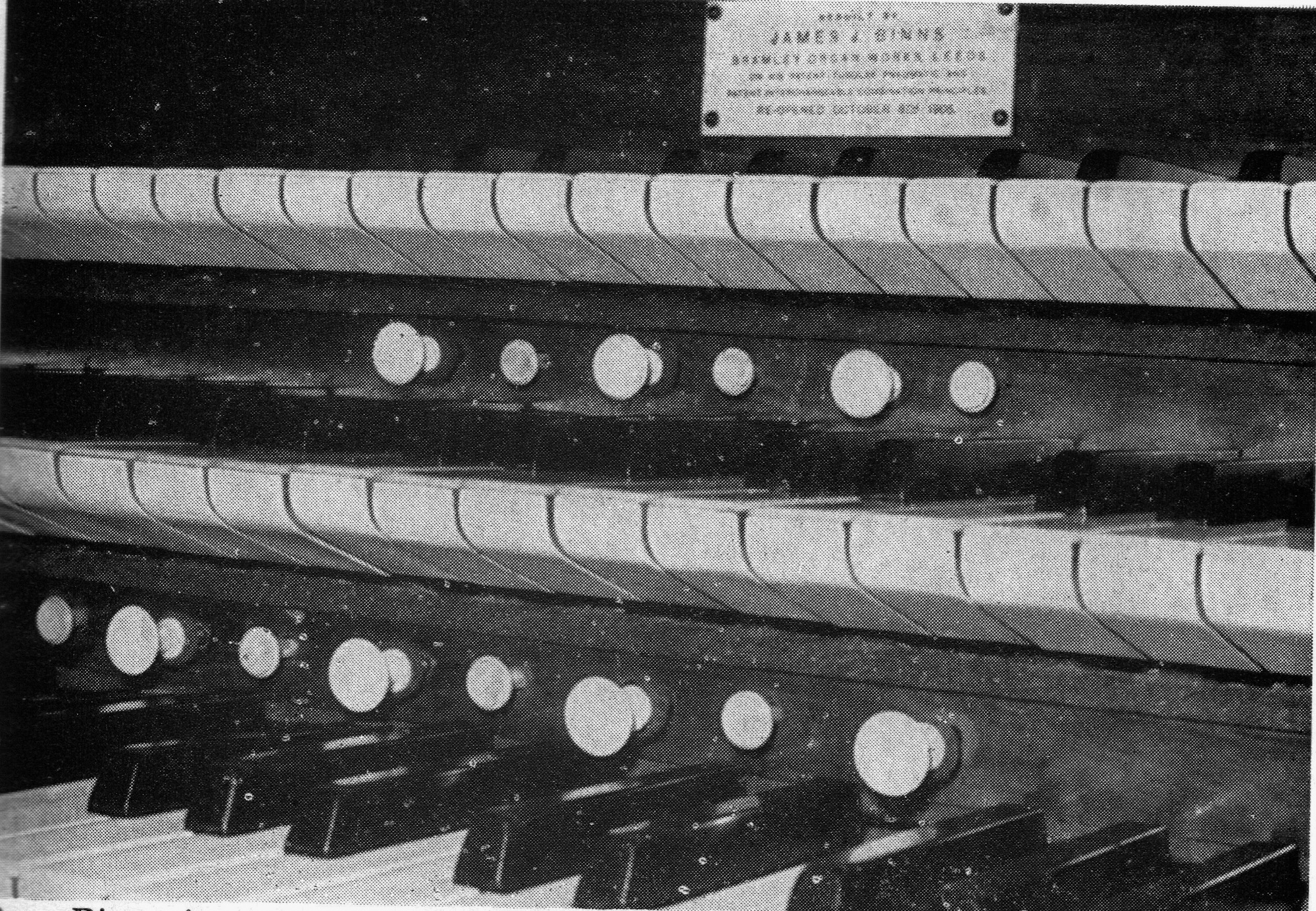
|
Binns'
tender for the rebuild contains these significant words:
“All
pipes to be carefully cleaned and where required
readjusted
or repaired. The pipes are not to be
interfered with in
any other way. Voicing and tone to
remain exactly as they
now are”
It
is easy to detect the influence of Thomas Cawthra here, but
Binns is said to have admitted carrying out modifications to
certain of the reed basses, some of which now have rubber
weights attached to their tongues - a material which Schulze is
unlikely to have used since it is absent from his later work
with unweighted reeds. The Pedal Organ soundboards were
remade, one being replaced, but the original manual soundboards
were retained, being overhauled and fitted with new pallets
whilst being prepared for tubular-pneumatic actions.
Several new reservoirs were provided to ensure a steady wind
supply to the individual soundboards, but some of the original
reservoirs were retained.
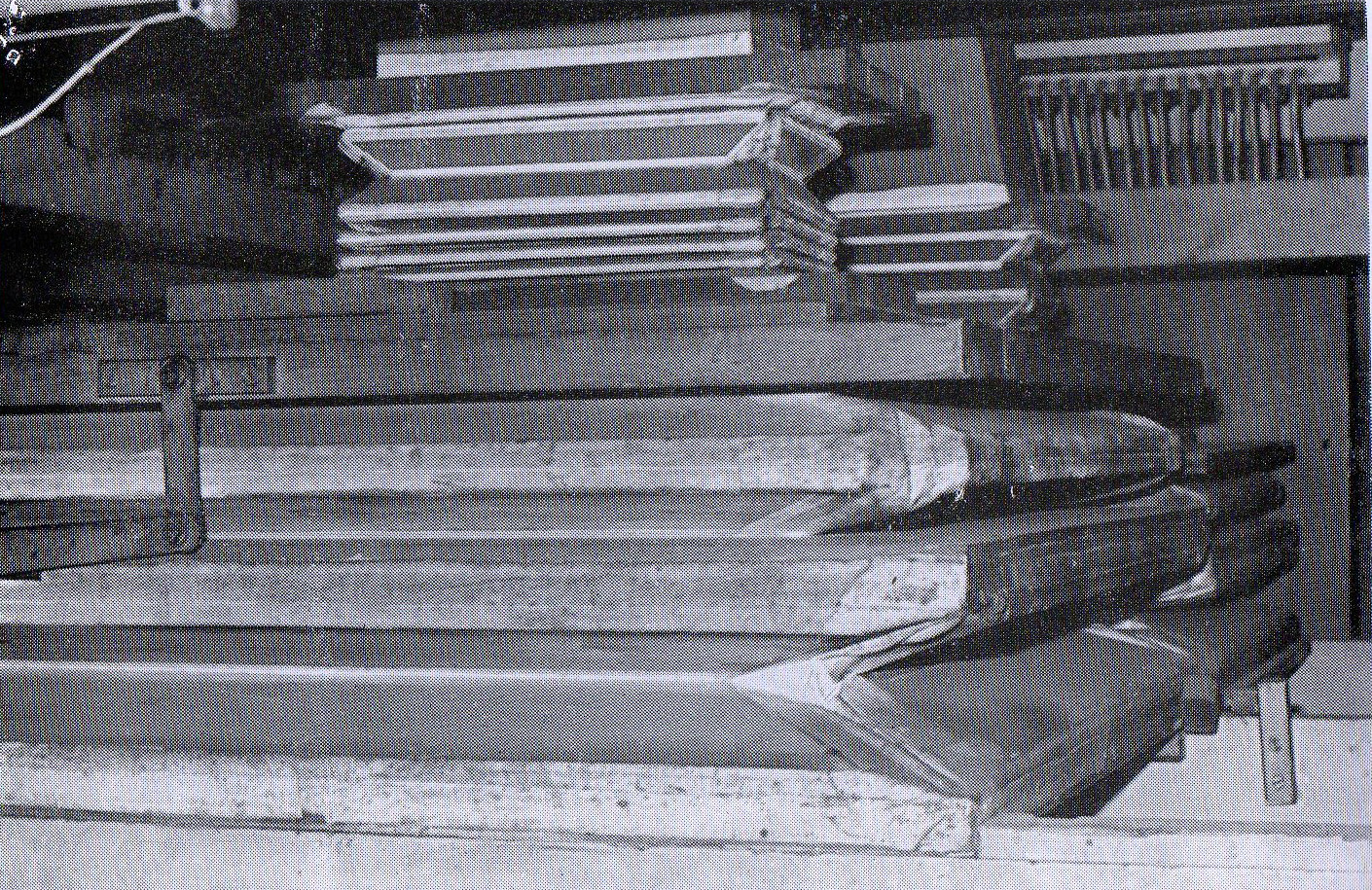 An
original Schulze reservoir still in use as a main reservoir
An
original Schulze reservoir still in use as a main reservoir
|
|
|
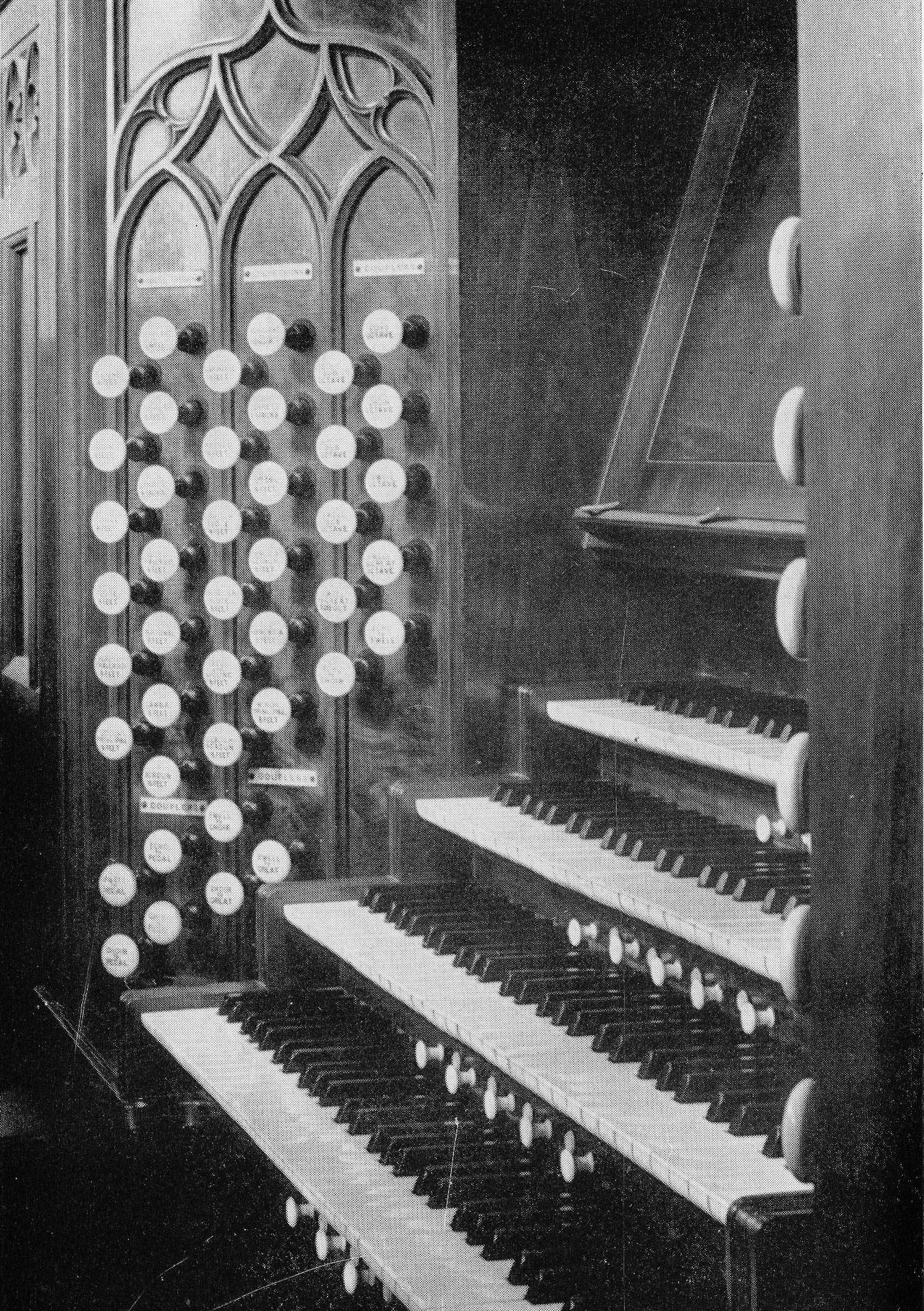 The
4-manual console by J.J.Binns (1905), with ivory stop knobs on
traceried burr walnut jambs, as used from 1905 to 1976.
The
4-manual console by J.J.Binns (1905), with ivory stop knobs on
traceried burr walnut jambs, as used from 1905 to 1976.
|
Binns'
original tender for this work was £1,390, but this must have
been considered excessive and certain items deleted since Mrs.
Caroline I. Eyres, of 19 Belgrave Square, London, and Dumbleton
Hall, Evesham, the widow of the donor of the organ who generously
defrayed the cost of the rebuild, wrote to the Vicar (the Rev. J.
B. Seaton) on 17th November, 1905:
“I
am so glad that you all seem to think the organ satisfactory; even
Binns seems pleased with it.
He wrote and told me he had
added the part that had been cut out of the estimate as he thought
they ought to put it in!”
We
are not told what Binns added at his own expense, but this action
shows his admiration for the organ and his determination to do the
best in his power for its welfare.
In
an attempt to improve the tonal balance of the Great Organ, Binns
inserted an additional Open Diapason 8ft. on the soundboard.
It is probable that this rank was inserted in place of the
Hohlflöte 8ft. since, as pointed out by Mr. J. J. F. Watkins,
the Hohlflöte 4ft. is of too small a scale to allow the bass
of a large Diapason 8ft. to take its place. Hence, since the
Hohlflöte 8ft. is grooved into the Gedact in the bass octave,
the substituted rank must have been of Tenor C compass, unless
indeed the bass was planted off - a costly method for such an
experiment! Fortunately, this substituted stop was not
retained in the 1905 rebuild in deference to the wishes of Mr.
Cawthra, although the tonal balance was improved by its insertion
according to Binns.
The
organ was re-opened at the Harvest Festival on 8th October, 1905,
and Mr. T. Cawthra gave a recital on 11th October as follows:
|

|
|
This
was followed by a recital by Mr. Tertius T. Noble, organist of
York Minster, on 15th November, 1905, which was noteworthy for the
time in that it consisted mainly of works composed for the organ,
and also because it included two compositions by contemporary
composers, Dr. Basil Harwood, and Dr. E. C. Bairstow, then
organist elect of Leeds Parish Church, who was to follow Tertius
Noble at York Minster in 1913. The concluding work by Julius
Reubke, dating from c.1856, was greatly introduced to England by
Mr. Noble, who made it specially his own.
The
programme was as follows:
|
|
|

